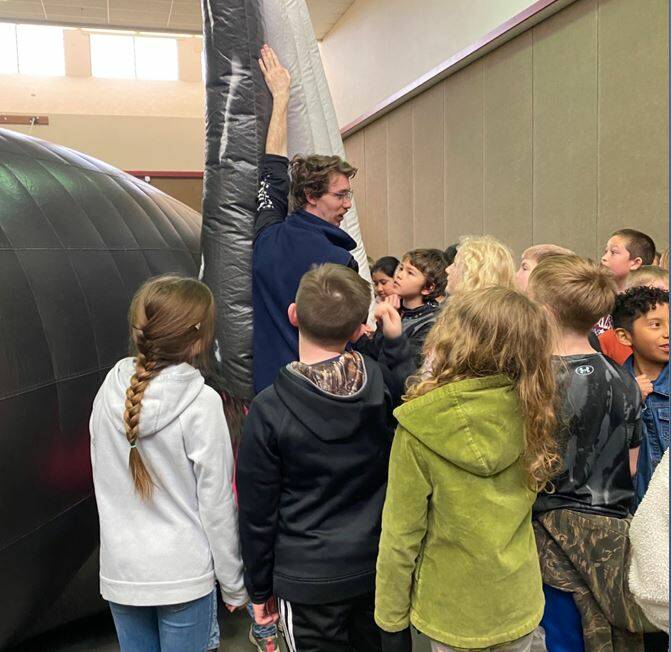By Vera Trainer
Local scientists from the Olympic Natural Resources Center (ONRC), the Olympic Coast National Marine Sanctuary (OCNMS) and the Washington State Department of Health (DOH) provided active participation to students from the Forks Elementary School with presentations and activities to encourage them to think about careers in science.
Fourth graders rotated between four groups of scientists who provided insights into their careers as oceanographers, forester ecologists, health department officials, and marine mammal biologists. The first rotation and a highlight of the day was “Big Mama”, the life-sized, walk-inside model of an actual humpback whale with the same name.
Sanctuary experts, including Christine VanDeen and Brendon Rager, guided students as they learned about the characteristics, behaviors, migration patterns, and their presence in the Pacific Northwest. Big Mama (the real one!) was one of the first humpback whales to be identified by her tail fluke, and is the oldest recorded whale in our region. We don’t know her true age, but she is estimated to be approximately 70 years old!
Big Mama has returned to the Washington waters every year since 2003 with a new calf almost every other year. One of her calves is called “Poptart” for its fondness of playfully popping out of the water! Students took a turn at being whale scientists through a fun fluke identification activity.
The next group was WA State Department of Health shellfish staff, Tracie Barry and Erin Hull, who performed a skit with costumes representing career opportunities in the DOH Shellfish Program, including a shellfish sampler, chemist, inspector, water quality specialist, and shellfish-related illness investigator. They shared ways that students can participate in safe shellfishing and “be shellfish friends” by harvesting shellfish in safe areas and keeping their beaches clean by recycling and picking up after their pets.
The third scientist, Courtney Bobsin, a forest ecologist from the Olympic Natural Resources Center, set up square plots to show student how trees and other vegetation are measured in the forest. Students rotated around the room looking at different leaves, bark, cones, and stems and guessing which plant they belonged to with the help of clues. The group discussed how they can use their senses to help them identify plants and why that is useful when studying forests.
Finally, Anthony Odell, a phytoplankton specialist from ONRC, showed the children the swimming behavior of microscopic organisms, called phytoplankton, which provide over half of the world’s oxygen. He spoke about how a small percentage of the world’s phytoplankton can produce poisons that can make our shellfish toxic. This was the first time some of the students had looked into a microscope!
Dr. Vera Trainer (ONRC) and Lieutenant Junior Grade (LTJG) Haley Wilson (NOAA Corps / OCNMS) visited the younger children’s classrooms to talk about careers in oceanography. They described the special gear they need while collecting samples at sea, including float coats, life jackets, and sometimes full-length orange survival suits.
Haley described her work NOAA ships in Alaska and the importance of being trained in multiple roles, including boat driver and firefighter, to meet the safety demands on NOAA vessels. Both scientists emphasized that science jobs are as diverse as the colors of the rainbow and emphasized to students that they were already becoming scientists if they had a curiosity about nature and its wonders.
Both scientists and students alike were inspired by this event.



